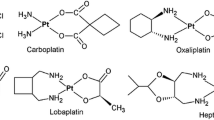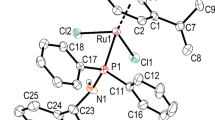Abstract
Seven new platinum(II) complexes (1–7) of triethylphosphine (Et3P) and thiones (L) with general formula, cis-[Pt(Et3P)2(L)2]Cl2 were prepared and characterized by elemental analysis, FTIR and NMR (1H, 13C & 31P) measurements. The analytical and spectroscopic data suggested the formation of the desired complexes. The complexes were tested for in vitro cytotoxicity against four cell lines: Hela (human cervical adenocarcinoma), MCF-7 (human breast carcinoma), A549 (human lung carcinoma), and HTC15 (human colon carcinoma). The anticancer activity values of compounds 1–6 are much better than cisplatin and carboplatin as indicated by their IC50 values.






Similar content being viewed by others
Change history
11 August 2020
Due to an unfortunate turn of events, the main affiliation of Dr. Saleh Altuwaijri was omitted from the above mentioned three articles. The complete affiliations are published below and should be treated as definitive.
References
Adam DM, Cornell JB (1967) Metal–sulfur Vibrations. Part I. Far-infrared spectra of some complexes of thiourea and Ethylenethiourea (Imidazolidine-2-thione). J Chem Soc. doi:10.1039/J19670000884
Ahmad S (2010) Platinum–DNA interactions and subsequent cellular processes controlling sensitivity to anticancer platinum complexes. Chem Biodiversity 7:543–566
Ahmad S, Isab AA, Perzanowski HP (2002) Ligand scrambling reactions of cyano(thione)gold(I) complexes and determination of their equilibrium constants. Can J Chem 80:1279–1284
Ahmad S, Isab A, Ali S (2006) Structural and mechanistic aspects of platinum anticancer agents. Transit Met Chem 31:1003–1016
Augustus TM, Anderson J, Hess SM, Bierbach U (2003) Bis(acridinyl-thiourea)platinum(II) complexes: synthesis, DNA affinity, and biological activity in glioblastoma cells. Bioorg Med Chem Lett 13:855–858
Dasari S, Tchounwou PB (2014) Cisplatin in cancer therapy: molecular mechanisms of action. Eur J Pharmacol 740:364–378
Dilruba S, Kalayda GV (2016) Platinum-based drugs: past, present and future. Cancer Chemother Pharmacol 77:1103–1124
Fuks L, Anuszewska E, Kruszewska H, Krowczynski A, Dudek J, Sadlej-Sosnowska N (2010) Platinum(II) complexes with thiourea derivatives containing oxygen, sulfur or selenium in a heterocyclic ring: computational studies and cytotoxic properties. Transit Met Chem 35:639–647
Hambley TW (2001) Platinum binding to DNA: structural controls and consequences. J Chem Soc Dalton Trans 19:2711-2718
Hartmann JT, Lipp HP (2003) Toxicity of platinum compounds. Expert Opin Pharmacother 4:889–901
Isab AA, Ahmad S, Arab M (2002) Synthesis of silver(I) complexes of thiones and their characterization by 13C, 15N and 107Ag NMR Spectroscopy. Polyhedron 21:1267–1271
Jamieson ER, Lippard SJ (1999) Structure, recognition, and processing of cisplatin—DNA adducts. Chem Rev 99:2467–2498
Johnstone TC, Suntharalingam K, Lippard SJ (2016) The next generation of platinum drugs: targeted Pt(II) agents, nanoparticle delivery, and Pt(IV) prodrugs. Chem Rev 116:3436–3486
Jung Y, Lippard SJ (2007) Direct cellular responses to platinum-induced DNA damage. Chem Rev 107:1387–1407
Kelland L (2007) The resurgence of platinum-based cancer chemotherapy. Nat Rev Cancer 7:573–584
Kennedy BP, Lever ABP (1972) Studies of the metal-sulfur bond. Complexes of the pyridine thiols. Can J Chem 50:3488–3507
Komeda S (2011) Unique platinum–DNA interactions may lead to more effective platinum-based antitumor drugs. Metallomics 3:650–655
Martins ET, Baruah H, Kramarczyk J, Saluta G, Day CS, Kucera GL, Bierbach U (2001) Design, Synthesis, and Biological Activity of a Novel Non-Cisplatin-type Platinum−Acridine Pharmacophore. J Med Chem 44:4492-4496
Marverti G, Cusumano M, Ligabue A, Di Pietro ML, Vainiglia PA, Ferrari A, Bergomi M, Moruzzi MS, Frassineti S (2008) Studies on the anti-proliferative effects of novel DNA-intercalating bipyridyl–thiourea–Pt(II) complexes against cisplatin-sensitive and -resistant human ovarian cancer cells. J Inorg Biochem 102:699–712
Mendia A, Cerrada E, Arnaiz FJ, Laguna M (2006) Pyridine-2-thionate as a versatile ligand in Pd(II) and Pt(II) chemistry: the presence of three different co-ordination modes in [Pd2(µ2-S,N-C5H4SN)(µ2-κ2 S,N-C5H4SN)(µ2-dppm)(S-C5H4SN)2]. Dalton Trans 609–616
Messori L, Merlino A (2016) Cisplatin binding to proteins: a structural perspective. Coord Chem Rev 315:67–89
Mustafa AZA, Altaf M, Monim-ul-Mehboob M, Fettouhi M, Wazeer MIM, Isab AA, Dhuna V, Bhatia G, Dhuna K (2014) Tetrakis(thione)platinum(II) complexes: synthesis, spectroscopic characterization, crystal structures and in vitro cytotoxicity. Inorg Chem Commun 44:159–163
Mustafa AZA, Monim-ul-Mehboob M, Jomaa MY, Altaf M, Fettouhi M, Isab AA, Wazeer MIM, Stoeckli-Evans H, Bhatia G, Dhuna V (2015) Tetrakis(thione)platinum(II) complexes: synthesis, spectroscopic characterization, crystal structures, and in vitro cytotoxicity. J Coord Chem 68:3511–3524
Pidcock A, Richards RE, Venanzi LM (1966) 195Pt–31P nuclear spin coupling constant and the nature of the trans-effect in platinum complexes. J Chem Soc A 1707–1710:1966
Power WP, Wasylishen RE (1992) Anisotropies of the 31P chemical shift and 31P–195Pt indirect spin-spin coupling in platinum(II) phosphines. Inorg Chem 31:2176–2183
Reedijk J (1999) Why does cisplatin reach guanine-N7 with competing S-donor ligands available in the cell? Chem Rev 99:499–2510
Screnci D, Mckeage MJ (1999) Platinum neurotoxicity: clinical profiles, experimental models and neuroprotective approaches. J Inorg Biochem 77:105–110
Sooriyaarachchi M, Gibson MA, Lima BDS, Gailer J (2016) Modulation of the metabolism of cisplatin in blood plasma by glutathione. Can J Chem 94:360
Timerbaev AR, Hartinger CG, Aleksenko SS, Keppler BK (2006) Interactions of antitumor metallodrugs with serum proteins: advances in characterization using modern analytical methodology. Chem Rev 106:2224–2248
Wang X, Guo Z (2007) The role of sulfur in platinum anticancer chemotherapy. Anticancer Agents Med Chem 7:19–34
Wheate NJ, Walker S, Craig GE, Oun R (2010) The status of platinum anticancer drugs in the clinic and in clinical trials. Dalton Trans 39:8113–8127
Wilson JJ, Lippard SJ (2014) Synthetic methods for the preparation of platinum anticancer complexes. Chem Rev 114:4470–4495
Wong D, Lippard SJ (2005) Cellular processing of platinum anticancer drugs. Nat Rev Drug Disc 4:307–320
Zutphen SV, Reedijk J (2005) Targeting platinum anti-tumour drugs: overview of strategies employed to reduce systemic toxicity. Coord Chem Rev 249:2845–2853
Acknowledgement
This research was supported by the King Fahd University Petroleum and Minerals Research Committee under project No. IN161005.
Author information
Authors and Affiliations
Corresponding author
Rights and permissions
About this article
Cite this article
Jomaa, M.Y., Altaf, M., Ahmad, S. et al. Synthesis, spectroscopic characterization and in vitro anticancer activity of new platinum(II) complexes with some thione ligands in the presence of triethylphosphine. Biometals 30, 787–795 (2017). https://doi.org/10.1007/s10534-017-0047-5
Received:
Accepted:
Published:
Issue Date:
DOI: https://doi.org/10.1007/s10534-017-0047-5




